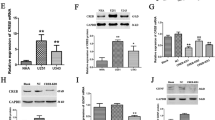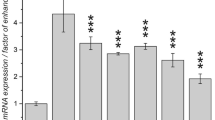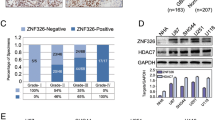Abstract
The mechanism underlying abnormally high transcription of the glial cell line-derived neurotrophic factor (GDNF) gene in glioma cells is not clear. In this study, to assess histone H3K9 acetylation levels in promoters I and II of the gdnf gene in normal human brain tissue, low- and high-grade glioma tissues, normal rat astrocytes, and rat C6 glioblastoma cells, we employed chromatin immunoprecipitation-polymerase chain reaction (ChIP-PCR), real-time PCR, and a pGL3 dual fluorescence reporter system. We also investigated the influence of treatment with curcumin, a histone acetyltransferase inhibitor, and trichostatin A (TSA), a deacetylase inhibitor, on promoter acetylation and activity and messenger RNA (mRNA) expression level of the gdnf gene in C6 cells. Compared to normal brain tissue, H3K9 acetylation in promoters I and II of the gdnf gene increased significantly in high-grade glioma tissues but not in low-grade glioma tissues. Moreover, H3K9 promoter acetylation level of the gdnf gene in C6 cells was also remarkably higher than in normal astrocytes. In C6 cells, curcumin markedly decreased promoter II acetylation and activity and GDNF mRNA expression. Conversely, all three measurements were significantly increased following TSA treatment. Our results suggest that histone H3K9 hyperacetylation in promoter II of the gdnf gene might be one of the reasons for its abnormal high transcription in glioma cells.





Similar content being viewed by others
References
Grimm L, Holinski-Feder E, Teodoridis J, Scheffer B, Schindelhauer D, Meitinger T, Ueffing M (1998) Analysis of the human GDNF gene reveals an inducible promoter, three exons, a triplet repeat within the 3'-UTR and alternative splice products. Hum Mol Genet 7:1873–1886
Baecker PA, Lee WH, Verity AN, Eglen RM, Johnson RM (1999) Characterization of a promoter for the human glial cell line-derived neurotrophic factor gene. Brain Res Mol Brain Res 69:209–222
Strömberg I, Björklund L, Johansson M, Tomac A, Collins F, Olson L, Hoffer B, Humpel C (1993) Glial cell line-derived neurotrophic factor is expressed in the developing but not adult striatum and stimulates developing dopamine neurons in vivo. Exp Neurol 124:401–412
Lin LF, Doherty DH, Lile JD, Bektesh S, Collins F (1993) GDNF: a glial cell line-derived neurotrophic factor for midbrain dopaminergic neurons. Science 260:1130–1132
Airaksinen MS, Saarma M (2002) The GDNF family: signalling, biological functions and therapeutic value. Nat Rev Neurosci 3:383–394
Ng WH, Wan GQ, Peng ZN, Too HP (2009) Glial cell-line derived neurotrophic factor (GDNF) family of ligands confer chemoresistance in a ligand-specific fashion in malignant gliomas. J Clin Neurosci 16:427–436
Ku M-C, Wolf SA, Respondek D, Matyash V, Pohlmann A, Waiczies S, Waiczies H, Niendorf T, Synowitz M, Glass R, Kettenmann H (2013) GDNF mediates glioblastoma-induced microglia attraction but not astrogliosis. Acta Neuropathol 125:609–620
Yu ZQ, Zhang BL, Ren QX, Wang JC, Yu RT, Qu DW, Liu ZH, Xiong Y, Gao DS (2013) Changes in transcriptional factor binding capacity resulting from promoter region methylation induce aberrantly high GDNF expression in human glioma. Mol Neurobiol 48:571–580
Lu DY, Leung YM, Cheung CW, Chen YR, Wong KL (2010) Glial cell line-derived neurotrophic factor induces cell migration and matrix metalloproteinase-13 expression in glioma cells. Biochem Pharmacol 80:1201–1209
Song H, Moon A (2006) Glial cell-derived neurotrophic factor (GDNF) promotes low-grade Hs683 glioma cell migration through JNK, ERK-1/2 and p38 MAPK signaling pathways. Neurosci Res 56:29–38
Nagarajan RP, Costello JF (2009) Molecular epigenetics and genetics in neuro-oncology. Neurotherapeutics 6:436–446
Gao J, Chen T, Liu J, Liu W, Hu G, Guo X, Yin B, Gong Y, Zhao J, Qiang B, Yuan J, Peng X (2009) Loss of NECL1, a novel tumor suppressor, can be restored in glioma by HDAC inhibitor-trichostatin A through Sp1 binding site. Glia 57:989–999
Yoshioka H, Kamitani H, Watanabe T, Eling TE (2008) Nonsteroidal anti-inflammatory drug-activated gene (NAG-1/GDF15) expression is increased by the histone deacetylase inhibitor trichostatin A. J Biol Chem 283:33129–33137
Schmidt N, Windmann S, Reifenberger G, Riemenschneider MJ (2012) DNA hypermethylation and histone modifications downregulate the candidate tumor suppressor gene RRP22 on 22q12 in human gliomas. Brain Pathol 22:17–25
Wu X, Chen PS, Dallas S, Wilson B, Block ML, Wang CC, Kinyamu H, Lu N, Gao X, Leng Y, Chuang DM, Zhang W, Lu RB, Hong JS (2008) Histone deacetylase inhibitors up-regulate astrocyte GDNF and BDNF gene transcription and protect dopaminergic neurons. Int J Neuropsychopharmacol 11:1123–1134
Chen PS, Peng GS, Li G, Yang S, Wu X, Wang CC, Wilson B, Lu RB, Gean PW, Chuang DM, Hong JS (2006) Valproate protects dopaminergic neurons in midbrain neuron/glia cultures by stimulating the release of neurotrophic factors from astrocytes. Mol Psychiatry 11:1116–1125
Zhang X, Wharton W, Yuan Z, Tsai S-C, Olashaw N, Seto E (2004) Curcumin, a novel p300/CREB-binding protein-specific inhibitor of acetyltransferase, represses the acetylation of histone/nonhistone proteins and histone acetyltransferase-dependent chromatin transcription. J Biol Chem 279:51163–51171
Zhang X, Wharton W, Yuan Z, Tsai SC, Olashaw N, Seto E (2004) Activation of the growth-differentiation factor 11 gene by the histone deacetylase (HDAC) inhibitor trichostatin A and repression by HDAC3. Mol Cell Biol 24:5106–5118
Terashvili M, Sarkar P, Nostrand MV, Falck JR, Harder DR (2012) The protective effect of astrocyte-derived 14, 15-epoxyeicosatrienoic acid on hydrogen peroxide-induced cell injury in astrocyte-dopaminergic neuronal cell line co-culture. Neuroscience 223:68–76
Das C, Lucia MS, Hansen KC, Tyler JK (2009) CBP/p300-mediated acetylation of histone H3 on lysine 56. Nature 459:113–117
Tada Y, Brena RM, Hackanson B, Morrison C, Otterson GA, Plass C (2006) Epigenetic modulation of tumor suppressor CCAAT/enhancer binding protein α activity in lung cancer. J Natl Cancer Inst 98:396–406
Kouzarides T (2007) Chromatin modifications and their function. Cell 128:693–705
Strahl BD, Allis CD (2000) The language of covalent histone modifications. Nature 403:41–45
Fry CJ, Peterson CL (2001) Chromatin remodeling enzymes: who's on first? Curr Biol 11:R185–R197
Castro LM, Gallant M, Niles LP (2005) Novel targets for valproic acid: up-regulation of melatonin receptors and neurotrophic factors in C6 glioma cells. J Neurochem 95:1227–1236
Bredy TW, Wu H, Crego C, Zellhoefer J, Sun YE, Barad M (2007) Histone modifications around individual BDNF gene promoters in prefrontal cortex are associated with extinction of conditioned fear. Learn Mem 14:268–276
Tsankova NM, Kumar A, Nestler EJ (2004) Histone modifications at gene promoter regions in rat hippocampus after acute and chronic electroconvulsive seizures. J Neurosci 24:5603–5610
Vaissière T, Sawan C, Herceg Z (2008) Epigenetic interplay between histone modifications and DNA methylation in gene silencing. Mutat Res 659:40–48
Acknowledgments
This project was supported by the National Natural Science Foundation of China (Grant numbers 31271358 and 81101899), Natural Science Foundation of Jiangsu Province (08KJB180011 and BK20130212), China Postdoctoral Science Foundation funded project (2013M540466), and a project funded by the Priority Academic Program Development of Jiangsu Higher Education Institutions (PAPD).
Author information
Authors and Affiliations
Corresponding author
Additional information
Zheng-Quan Yu and Bao-Le Zhang contributed equally to this work.
Rights and permissions
About this article
Cite this article
Yu, ZQ., Zhang, BL., Ni, HB. et al. Hyperacetylation of Histone H3K9 Involved in the Promotion of Abnormally High Transcription of the gdnf Gene in Glioma Cells. Mol Neurobiol 50, 914–922 (2014). https://doi.org/10.1007/s12035-014-8666-0
Received:
Accepted:
Published:
Issue Date:
DOI: https://doi.org/10.1007/s12035-014-8666-0




